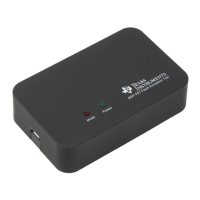Debug Probes Hardware and Software
www.ti.com
16
SLAU647F–July 2015–Revised December 2016
Submit Documentation Feedback
Copyright © 2015–2016, Texas Instruments Incorporated
MSP Debuggers
5.6.2 Backchannel UART
The MSP-FET supports the Backchannel UART functionality only when using an MSPDebugStack
v3.4.1.0 or higher for the MSP-FET connection.
The baud rates that are supported depend on the target configuration and the debug settings. Table 2
shows which baud rates are supported with certain configuration combinations.
✓ means that the corresponding baud rate is supported without any data loss with the specified
combination of settings.
✗ means that the corresponding baud rate is not supported (data loss is expected) with the specified
combination of settings.
Table 2. MSP-FET Backchannel UART Implementation
Target MCLK
Frequency:
1 MHz 8 MHz 1 MHz 8 MHz
Debugger: Active Inactive
Flow Control: No Yes No Yes No Yes No Yes
4800 baud ✓ ✓ ✓ ✓ ✓ ✓ ✓ ✓
9600 baud ✓ ✓ ✓ ✓ ✓ ✓ ✓ ✓
19200 baud ✓ ✓ ✓ ✓ ✓ ✓ ✓ ✓
28800 baud ✗ ✓ ✓ ✓ ✓ ✓ ✓ ✓
38400 baud ✗ ✓ ✗ ✓ ✗ ✓ ✗ ✓
57600 baud ✗ ✓ ✗ ✓ ✗ ✓ ✗ ✓
115200 baud ✗ ✗ ✗ ✓ ✗ ✗ ✗ ✓
5.6.2.1 UART Backchannel Activation Commands
The MSP-FET supports two different Backchannel UART modes, one with flow control and one without.
The different modes can be selected by opening the corresponding COM port with a dedicated baud rate.
See Table 3 for the specific baud rates for each command.
NOTE: The baud rates used by these activation commands cannot be used for communication.
NOTE: The Backchannel UART is disabled until the COM port is opened with a valid baud rate.
If none of the specified commands are transferred before setting the communication baud rate,
communication starts with the default settings: 3.3-V target V
CC
, no flow control mechanism.
Table 3. MSP-FET Backchannel UART Activation Commands
Baud Rate Command
9620 Set all backchannel UART pins to high impedance – no current flow into target device
9621 Configure backchannel UART communication without handshake (default start behavior)
9622 Configure backchannel UART communication with handshake
9623
Voltage configuration command. When this command is received, target V
CC
is set to 3.3 V. After target V
CC
is configured, it is switched through to the target device.

